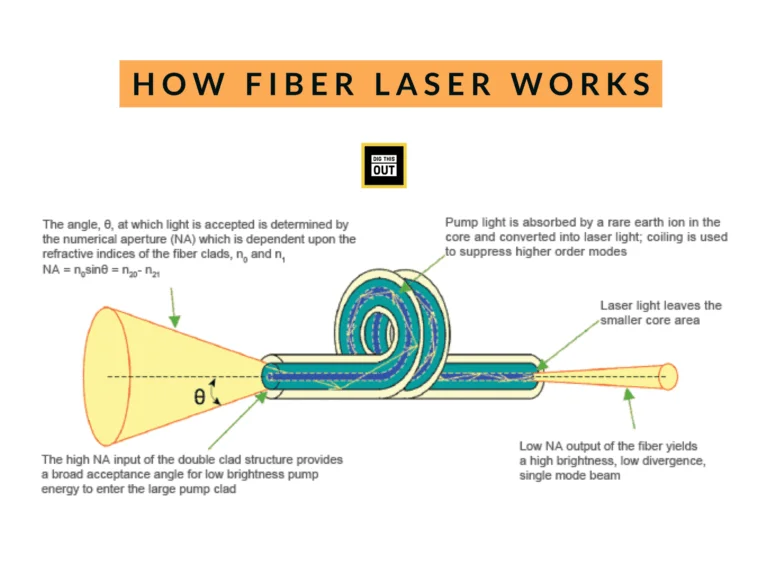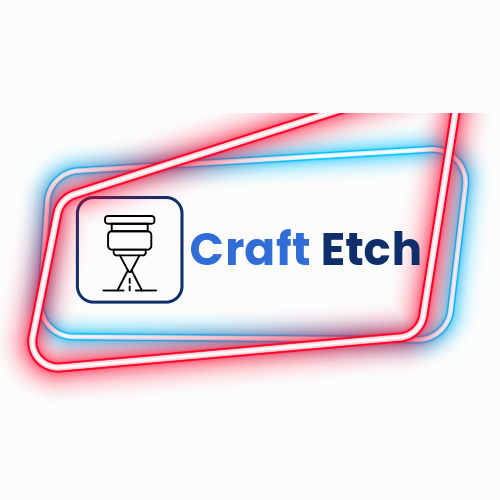Join Workshops
Physical Address
304 North Cardinal St.
Dorchester Center, MA 02124
What is a fiber laser?
A fiber laser is a type of laser that uses an active optical fiber as the gain medium. The optical fiber is doped with rare–earth elements such as erbium, ytterbium, or neodymium. Fiber lasers use a single–mode optical fiber as the gain medium, meaning that the light is kept as a single beam, as opposed to a multimode optical fiber, which allows multiple beams of light to travel through it.
Fiber lasers are more efficient and require less power than traditional lasers and can be used for applications such as cutting, welding, marking, and engraving industrial sheet metals along with stainless steel, copper, and Titanium.
There are mainly two types of fiber laser, MOPA fiber laser and Q-switched fiber laser. The main difference between the MOPA and Q-switched fiber is laser is:
You can control pulse and frequency and create color laser engravings with MOPA lasers.
How Fiber Laser Works?
Fiber laser produces a beam of light with a very narrow spectral width. It makes the laser highly efficient in its ability to absorb the energy from its pump source and convert it into a laser beam.
The laser uses rare–earth elements such as erbium, ytterbium, or neodymium, which helps the gain medium to be embedded in the core of the optical fiber. Fiber pumping with high power light source helps the beam generation, which further exists in the fiber through the end.

The first stage of a fiber laser is the creation of pump light, where initially, the lights enter into the laser system. Since electricity is the primary energy source the pump diodes work as a converter tool to transform electricity into pump light.
After that, a coupler helps combine the light from multiple diodes into one. It multiplies the laser beam and ensures that there is a single exit point by which the laser gets connected with the primary fiber.
After the collection of all-laser reflections, the light then travels into the gain medium.
In the very next stage, the pump light passes through the optical fiber, which consists of two major components. One is ‘Core’ which offers the passway to the light and is made of silica glass. The other part is ‘Cladding’, which provides a tight coating to the ‘Core’ so that the light travels uninterrupted.
Fiber lasers do sometimes lose some of their heat depending on the perfection of the Cladding it has; however, it always maintains the required wavelength due to the technical surroundings.
After passing through the optical fiber, the light strikes and reacts with the electrons. Even if the electrons are at a low energy level, they produce photons depending on wavelengths. The photons then interact with other electrons or return to a relaxed state.
This is how the laser beam flows steadily and helps in cutting heavy materials such as industrial sheet metal.
We listed some portable fiber lasers here that can engrave metal.
How to measure fiber laser strength?
There are several parameters by which you can measure the performance of a fiber laser.
The wavelength of a fiber laser is typically around 1 micron (1000 nanometers). The wavelengths may vary between 780 nm and 2200 nm, which is invisible to the human eye. This frequency is achieved when the wavelength is between the Infrared & the Ultraviolet ray.

However, the green fiber laser beam is noticed by the human eyes and works well in soft materials such as Gold, Glass, Silicone, and Copper. Such Green lasers are used to make holograms and surgery.
Even though we have seen that the CO2 lasers are measured in Watt, so do the fiber lasers. But there are some differentiations.
For instance, a 100 watts fiber laser can reach up to 10,000 Watts of peak power since the pulsed fiber laser does not produce constant energy.
Application of Fiber Laser
These are works done by fiber lasers. There may be similarities between CO2 lasers, but, depending on the toughness, the role of fiber laser appears.
Laser Cutting
Fiber laser power is used to cut thick materials such as industrial steel & other sheet metals. Similarly, cutting stainless steel and other heavier materials would require fiber lasers.
Just a recap, A co2 laser cannot cut Stainless steel since the shininess of stainless steel reflects the laser beam backward.
Benefits of Fiber laser cutting.
- Ability to cut thicker materials
- Faster cutting
- Better Precision & less wastage
- Con-contact process & there is a low risk of system loss.
- Improves processing time
- Low operating costs
Cons of Fiber Laser cutting
- It’s more expensive than the CO2 lasers
- Required experience & safety precautions
- It may bring heat damage if materials are not suitable for the given laser strength.
Laser Welding
Fiber laser can also be worked as a welding machine and has become popular due to its faster speed & efficiency.
Laser beam welding (LBW) is a welding technique used to join multiple pieces of metal through the use of a laser. The laser beam provides a concentrated heat source, allowing for narrow, deep welds and high welding rates. LBW is used primarily in high-volume applications, such as the automotive, aerospace, and electronics industries. In LBW, a laser beam is focused on the surface of the two materials to be joined. The laser radiation is absorbed by the material, creating a molten pool at the joint interface. The molten pool is then stirred and allowed to solidify, forming a solid joint.
Laser Engraving
Laser marking is the process of using a laser for etching or engraving an object. The technology can be used to mark a wide variety of materials, such as plastic, metal, and glass. Laser marking is more precise than traditional marking methods, such as engraving, printing, and stenciling, and can produce high–quality, permanent marks on a variety of surfaces. Laser marking is used for a range of applications, including product identification, security marking, and decorative engraving.
Laser Cleaning
A fiber laser can also be utilized in laser cleaning. Laser cleaning is the process of using a laser to remove dirt, rust, paint, or other materials from a surface. The process is non–abrasive and produces no further waste, making it an environmentally friendly alternative to traditional cleaning methods. Laser cleaning can be used on a variety of materials, including metals, stones, and glass.



